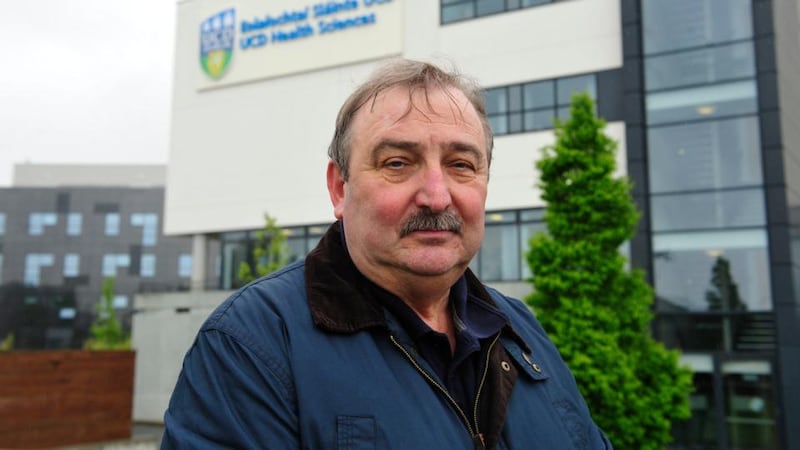If one of your loved ones collapsed in front of you because their heart suddenly stopped beating, would you know what to do? Most of us would feel helpless to act during a cardiac emergency because we are not trained to administer cardiopulmonary resuscitation (CPR) or we are afraid of hurting the victim.
With about 60 per cent of collapses occurring in front of family or friends – often in the home – the reality is that you could be called on to save the life of a loved one. By using a very simple technique, you could double or even triple their chance of survival.
For every minute a person is collapsed without receiving CPR or defibrillation (the delivery of an electric shock to the heart), their chance of survival decreases by 8-10 per cent. After five minutes, their chance of survival may be reduced by as much as 50 per cent, so waiting for the ambulance to arrive can make it too late.

However, Irish Heart Foundation (IHF) basic life-support resuscitation expert Brigid Sinnott explains that, without any specialised training, you can still help to save a life by using hands-only CPR to provide continuous chest compressions to victims of sudden cardiac arrest.
Hands-only CPR, also known as compression-only CPR, has been shown to be as effective as conventional CPR for sudden cardiac arrest at home, at work or in public, according to the American Heart Association. It can double or even triple a victim's chance of survival and can be performed effectively by children from as young as 10.
Hard and fast campaign
The IHF is following in the footsteps of the British Heart Foundation, which launched a major "hard and fast" hands-only cardiopulmonary resuscitation campaign fronted by hard-man actor Vinnie Jones in 2012 to raise awareness of the technique.
The IHF’s 25th Happy Hearts Appeal takes place this week, from Thursday to Saturday, with all money raised going directly into educating adults and young people on how to deliver compression-only CPR.
Every year in Ireland, an estimated 5,000 people die suddenly from cardiac arrest when their hearts stop beating; between 70 and 100 of these deaths occur in people under the age of 35. Seven out of 10 of these deaths happen in public view, according to the IHF, and often in the presence of a bystander.
However, as Sinnott points out, their chances of survival can greatly improve if a bystander is able to keep their heart going through hands-only CPR until a first responder with a defibrillator or ambulance arrive at the scene.
“Many people are afraid to do CPR in an emergency because of their lack of knowledge,” she says, “and many more are put off by the thought of having to give the kiss of life. We are urging the public to forget the kiss of life, and go straight to hard and fast compressions on the chest after calling 999 or 112 to make sure emergency services are on the way.
“The bottom line is that if you do not start compressions, that person will die. You can do no harm.”
If someone collapses in front of you and is not breathing or responsive, the advice is to lock the fingers of your two hands together and start pushing down hard and fast in the centre of the chest, about two pushes a second, to the beat of the Bee Gees' disco classic Stayin' Alive, which has 100 beats per minute. Keep going until the ambulance arrives or the victim wakes up and starts breathing normally.
Remember the rhythm
People feel more confident performing hands-only CPR and are more likely to remember the correct rhythm when trained to the beat of Stayin' Alive, according to the American Heart Association.
CPR with compressions and breaths is still recommended by the American Heart Association for infants and children, victims of drowning, drug overdose, and people who collapse due to breathing problems.
The ideal scenario in the event of a cardiac collapse, Sinnott says, is for the patient to have CPR and defibrillation within eight minutes before the ambulance arrives.
This is where the State’s network of First Responder Schemes comes in (see panel).
“Currently in Ireland, more than 60 per cent of people in cardiac arrest do receive bystander CPR, which is very high by international standards. The average rate is estimated at about 30 per cent.
“We are doing really well but 40 per cent of people still do not get help in the vital minutes after they collapse, which is why we need to educate the wider public in how to administer hands-only CPR.”
The public is encouraged to support the Irish Heart Foundation's Happy Hearts appeal by buying a happy heart pin for €2 from volunteers or in SuperValu stores from this Thursday, May 15th, to Saturday, May 17th.
For more details go to happyhearts.ie
‘There is no national funding available for First Responder schemes, they are funded by members of the local community’
There are many well-established Community First Responder schemes operating in communities around the State.
A Community First Responder is a volunteer trained in basic life support and the use of an automated external defibrillator (AED) who assists the ambulance service by providing life-saving treatment to critically ill people in those vital minutes prior to the arrival of an ambulance.
Brigid Sinnott of the Irish Heart Foundation (IHF) says that as there is no national funding available for these schemes, they are funded by members of the local community. Each group raises funds for training and the purchase of an AED.
"It costs about €1,500 per AED and there is the ongoing cost of batteries and pads, but communities are generally very receptive to donating as they know this is something that is going to save lives in their community," Sinnott adds. "We are training instructors to go out and train community groups. However, it's all still a bit ad hoc and we really need to get a proper plan in place nationally."
Andrew Patton, a fourth-year medical student at UCD, was interested in setting up a Community First Responder scheme in Dalkey, so he contacted the HSE and members of the local community, including sporting clubs, business-association representatives, the local priests and community gardaí.
He wanted to see if they felt there was a need for such a service and he encountered a very positive response.
“A lot of people had never considered the idea of a First Responder scheme for Dalkey but had heard of them in the west of Ireland or remote areas of Kerry, where people could be waiting 20 minutes or longer for an ambulance.
“The whole idea, though, is to get CPR and early defibrillation started as soon as possible. Even if we are only a few minutes before the ambulance, every minute counts.”
In setting up the Dalkey group, Patton received huge support from John Fitzgerald of the Wicklow Cardiac First Responder Group, which is an umbrella group for 31 community responder schemes in Co Wicklow. He was also fortunate to receive an anonymous donation of an AED when he advertised for volunteers to join the scheme.
The Dalkey CFR scheme is affiliated with the Red Cross and it already has 15 First Responders trained and six more volunteers involved in fundraising, publicity and other roles. They are also linked to the HSE so they follow the national policy for first responder schemes.
"Our aim is to start fundraising for a second AED so that we can set up a buddy system and have two responders on call each night," says Patton.
The Dalkey Community First Responders Scheme will be launched with a family day on Killiney Hill on Saturday from 1-4pm.
The Ambulance Service, Fire Brigade and An Garda Síochána will be opening a number of their vehicles to the public on the day and there will be interactive CPR demonstrations for all ages.
For further information, dalkeycfr.ie
In the middle of the CPR talk 'I just fell off my chair'
When Brian Bruno collapsed with a heart attack in the middle of giving a training course, it took his students a few seconds to realise that he was not acting.
What were the chances of a CPR trainer having a sudden cardiac arrest with no warning signs in front of his class of advanced paramedics?
It was certainly a case of "right time, right place" for Bruno, who firmly believes he would not be here today if his heart attack had happened anywhere else.
He jokingly admits that he was very lucky to collapse in front of a group of advanced paramedics with a defibrillator beside him.
Bruno, who is 50, trains the Irish Heart Foundation's army of lifesavers around Ireland and works as a full-time tutor in advanced paramedics at University College Dublin.
Before his move to Ireland in 2005, he was a paramedic with the English ambulance service for 25 years.
Suffice it to say he has seen his fair share of emergency situations over the course of his career.
However, he makes the point that no matter how many advanced skills our paramedics equip themselves with, they still need members of the public to keep the patient's heart going until they get to the scene.
Scared of infection
"Lots of people are apprehensive about mouth-to-mouth resuscitation for various reasons, which I can understand. They may be scared that they can pick up an infection or that the person who had the heart attack may have vomited.
“Compression-only CPR is sufficient to keep oxygenated blood getting to the vital organs until the emergency services arrive,” he says.
On August 14th, 2009, Bruno had his heart attack on the first day of a training course in Cork.
"I gave a Powerpoint presentation, showed them a defibrillator which I was going to go back to later and then basically collapsed in front of them. I had none of the classic warning signs such as sweating or chest pain. I just fell off my chair.
“It took them a few seconds to realise it wasn’t part of my talk. I was unconscious and not breathing so I was technically dead.”
Luckily Bruno’s students quickly jumped into action and shocked him once with a defibrillator to restart his heart.
He ended up having surgery in Cork University Hospital to clear a blockage from one of his main coronary arteries.
“This is why bystander compression is so important. As my experience shows, not everybody gets the classic signs.
“The best thing you can do for somebody if they collapse in front of you is to call for help and start pushing down on their chest.
“We need to increase the number of people doing something rather than nothing in these situations.”
Michelle McDonagh

















